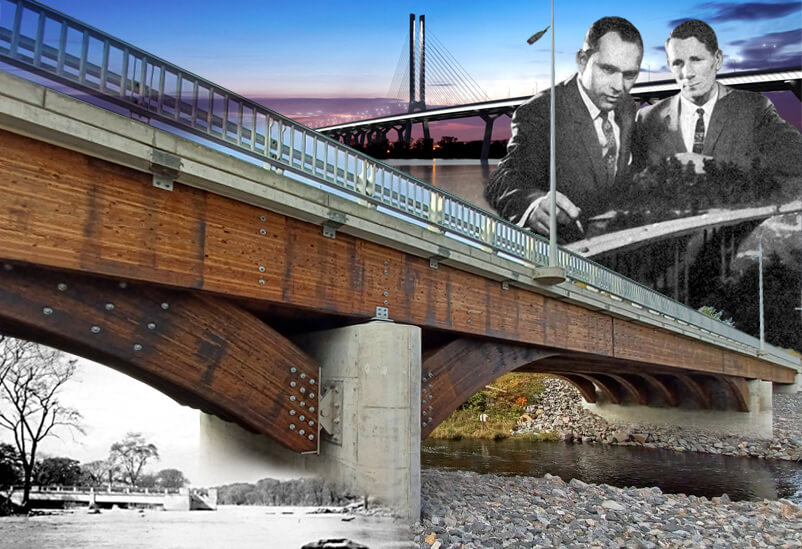
LEA has been at the forefront of designing innovative and complex bridges since 1954, a pivotal year marked by Hurricane Hazel, one of Canada’s worst natural disasters within the last century. The day after the hurricane, LEA’s founding firm, Lazarides, Lount and Partners, obtained their first bridge project for the replacement of Highway 401 Humber River Bridge after it was wiped out by the hurricane.
From that day forward, LEA has maintained a track record of successfully delivering complex bridge projects, including new bridges, replacements, and the rehabilitation of existing structures. Over the past decade alone, LEA has designed more than 75 complex multi-span bridges, with some involving bridge architecture and heritage preservation suited to landmarks in various locations and environments. Among these projects, the Duchesnay Creek Bridge in North Bay, Ontario, comprises a glue-laminated superstructure, which was the recipient of several awards including the 2021 OPWA Project of the Year award and the 2022 Ontario Concrete Awards for Pre-cast Infrastructure.
Designing Complex Bridges and More
The replacement of the Duchesnay Creek Bridge on Highway 17B, originally built in 1937, was prominent among deck trusses considering its extremely rare design and use of timber as a construction material. Prior to its replacement, it remained the last surviving timber deck truss bridge on Ontario’s highways. The replacement of this 74-metre-long heritage deck truss pays homage to the cultural heritage significance of the original structure through a timber design that is efficient and reflects the key attributes of the original timber structure in modern form. The selection of superstructure materials and timber durability also pioneered modern timber design in support of a movement to transition Canada to a low-carbon, renewable resources economy.
LEA’s experience in bridge engineering has not only propelled us to excel in this field but has also opened doors to other notable infrastructure projects. This included the complex tunnel structures that LEA designed for the Right Honourable Herb Gray Parkway. LEA completed the design of the Labelle Tunnel T-2, a multi-cell tunnel over 50-metres wide and 240-metres in length, using NU Girders and precast concrete deck panels composite to the girders. Through refined analysis of the superstructure and integrated bearings, the design was the only tunnel on the project exclusive of expansion joints. The tunnel was covered with approximately 800 millimetres of fill and a service road intersection complete with traffic signal pole bases and illumination. LEA also worked on the design of Highway 3 South Service Road, which was a multi-span continuous trapezoidal post-tensioned bridge comprising of three spans (55, 45, and55 metres). The deck featured a reverse crossfall transition along the entire bridge that was coordinated with the highway alignment, roadside safety barrier protection, vertical and horizontal clearances, and retaining wall interfacing. For the Rt. Hon. Herb Gray Parkway, LEA was also responsible for the complete design of the entire highway electrical systems including illumination and the Intelligent Transportation Systems (ITS) along the corridor. At the tunnels, the ITS systems included CCTV cameras, fire life safety systems, and emergency call stations for the public green spaces above.
Bridging the Path to New Service Offerings
Over the last few decades, LEA has expanded its bridge design and engineering services to incorporate technology systems and innovations. Our design of ITS for bridges and highways has included the new Samuel De Champlain Bridge in Montreal, the Thousand Island International Bridge crossings between Ontario and the state of New York, and the Halifax Harbour Bridges in Nova Scotia. These ITS systems include components for traffic monitoring, lane control, digital message signs, automated lane closures, weigh-in-motion, vehicle detection, road and weather monitoring, security, and communications networks supporting ITS, structural health monitoring, navigational lighting, and architectural lighting. Our team has also completed Threat, Vulnerability and Risk assessments for bridges and their supporting infrastructure.
To complement our bridge engineering services, LEA also specializes in environmental assessments (EA). This process serves as a crucial planning and decision-making tool that evaluates the potential environmental effects of a proposed project. The EA process ensures that public and Indigenous consultation, alternative solutions, mitigation measures, and monitoring plans are considered before a project is approved.
One component of the EA process is the evaluation of the natural environment. Baseline data is collected on the existing conditions and features within the study area, such as water quality, fish and wildlife habitat, vegetation, Species at Risk, wetlands, groundwater, air quality, excess soils and contamination, noise, and climate change. The baseline dataset is used to identify the potential environmental effects of the proposed project and its alternatives, as well as the mitigation measures that can be implemented to avoid or minimize the adverse effects. The natural environment assessment and EA process is documented in an EA report and submitted to the relevant authorities for review and approval.
Hurricane Hazel stands as a stark reminder of the immense power of nature, leaving a path of devastation and affecting countless lives. It underscores the significance of our work and our commitment to excellence. In response to the disaster, LEA’s engineers took decisive action and played a crucial role in rebuilding and restoring the community. Today, we honour their legacy by following in their footsteps, actively working to build and connect communities through innovative bridge engineering and urban infrastructure projects.